Angelica Kauffman
Maria Anna Angelika Kauffmann RA (30 October 1741 – 5 November 1807), usually known in English as Angelica Kauffman,[lower-alpha 1] was a Swiss Neoclassical painter who had a successful career in London and Rome. Remembered primarily as a history painter, Kauffmann was a skilled portraitist, landscape and decoration painter. She was, along with Mary Moser, one of the two female founding members of the Royal Academy in London in 1768.[2][3]
Angelica Kauffman | |
|---|---|
 Self-portrait by Kauffman, 1770–75 | |
| Born | Maria Anna Angelika Kauffmann 30 October 1741 |
| Died | 5 November 1807 (aged 66) |
| Nationality | Swiss |
| Known for | Painting |
| Movement | Neoclassicism |
Early life
_01.jpg)
Kauffman was born at Chur in Graubünden, Switzerland. Her family moved to Morbegno in 1742, then Como in Lombardy in 1752 at that time under Austrian rule. In 1757 she accompanied her father to Schwarzenberg in Vorarlberg/Austria where her father was working for the local bishop.[6] Her father, Joseph Johann Kauffmann, was a relatively poor man but a skilled Austrian muralist and painter, who was often traveling for his work. He trained Angelica and she worked as his assistant, moving through Switzerland, Austria, and Italy. Angelica, a child prodigy, rapidly acquired several languages from her mother, Cleophea Lutz, including German, Italian, French and English.[7] She also showed talent as a musician and was forced to choose between opera and art. She quickly chose art as a Catholic priest told Kauffman that the opera was a dangerous place filled with "seedy people."[8] By her twelfth year she had become known as a painter, with bishops and nobles being her sitters.
In 1754, her mother died and her father decided to move to Milan.[8] Later visits to Italy of long duration followed.[9] She became a member of the Accademia di Belle Arti di Firenze in 1762.[10] In 1763 she visited Rome, returning again in 1764. From Rome she passed to Bologna and Venice, everywhere feted for her talents and charm. Writing from Rome in August 1764 to his friend Franke, Winckelmann refers to her popularity; she was then painting his picture, a half-length; of which she also made an etching. She spoke Italian as well as German, he says, and expressed herself with facility in French and English - one result of the last-named accomplishment being that she became a popular portraitist for British visitors to Rome. "She may be styled beautiful," he adds, "and in singing may vie with our best virtuosi".[9] In 1765, her work appeared in England in an exhibition of the Free Society of Artists. She moved to England shortly after and established herself as a leading artist.[8]
Years in Great Britain
While in Venice, Kauffman was persuaded by Lady Wentworth, the wife of the British ambassador, to accompany her to London. One of the first pieces she completed in London was a portrait of David Garrick, exhibited in the year of her arrival at "Mr Moreing's great room in Maiden Lane." The rank of Lady Wentworth opened society to her, and she was everywhere well received, the royal family especially showing her great favor. Her firmest friend, however, was Sir Joshua Reynolds. In his pocket-book her name as "Miss Angelica" or "Miss Angel" appears frequently; and in 1766 he painted her, a compliment which she returned by her Portrait of Sir Joshua Reynolds. Another instance of her intimacy with Reynolds is to be found in her variation of Guercino's Et in Arcadia ego, a subject which Reynolds repeated a few years later in his portrait of Mrs Bouverie and Mrs Crewe.[9]
In 1767 Kauffman was seduced by an imposter going under the name Count Frederick de Horn, whom she married, but they were separated the following year.[9][11] It was probably owing to Reynolds's good offices that she was among the signatories to the petition to the king for the establishment of the Royal Academy. In its first catalogue of 1769 she appears with "R.A." after her name (an honour she shared with one other woman, Mary Moser); and she contributed the Interview of Hector and Andromache, and three other classical compositions.[12] She spent several months in Ireland in 1771, as a guest of the Lord Lieutenant of Ireland, and undertook a number of portrait commissions there. Her notable Irish portraits include those of Philip Tisdall, the Attorney General for Ireland, and his wife Mary, and of Henry Loftus, 1st Earl of Ely and his family, including his niece Dorothea Monroe, the most admired Irish beauty of her time.[13] It appears that among her circle of friends was Jean-Paul Marat, then living in London and practising medicine, with whom she may have had an affair.[14][lower-alpha 2]
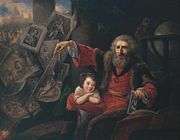
Her friendship with Reynolds was criticized in 1775 by fellow Academician Nathaniel Hone, who courted controversy in 1775 with his satirical picture The Conjurer.[lower-alpha 3] It was seen to attack the fashion for Italian Renaissance art and to ridicule Sir Joshua Reynolds, leading the Royal Academy to reject the painting. It also originally included a nude caricature of Kauffman in the top left corner, which he painted out after she complained to the academy. The combination of a little girl and an old man has also been seen as symbolic of Kauffman and Reynolds's closeness, age difference, and rumoured affair.[17][15]
From 1769 until 1782 Kauffman was an annual exhibitor with the Royal Academy, sending sometimes as many as seven pictures, generally on classical or allegoric subjects. One of the most notable was Leonardo expiring in the Arms of Francis the First (1778).[18][lower-alpha 4]
In 1773 she was appointed by the Academy with others to decorate St Paul's Cathedral, a scheme that was never carried out, and it was she who, with Biagio Rebecca, painted the Academy's old lecture room at Somerset House.[18]
History painting

While Kauffman produced many types of art, she identified herself primarily as a history painter, an unusual designation for a woman artist in the 18th century. History painting was considered the most elite and lucrative category in academic painting during this time period and, under the direction of Sir Joshua Reynolds, the Royal Academy made a strong effort to promote it to a native audience more interested in commissioning and buying portraits and landscapes. Despite the popularity that Kauffman enjoyed in British society, and her success there as an artist, she was disappointed by the relative apathy of the British towards history painting. Ultimately she left Britain for the continent, where history painting was better established, held in higher esteem and patronized.[20]
History painting, as defined in academic art theory, was classified as the most elevated category. Its subject matter was the representation of human actions based on themes from history, mythology, literature, and scripture. This required extensive learning in biblical and Classical literature, knowledge of art theory and a practical training that included the study of anatomy from the male nude. Most women were denied access to such training, especially the opportunity to draw from nude models; yet Kauffman managed to cross the gender boundary to acquire the necessary skill to build a reputation as a successful history painter who was admired by colleagues and eagerly sought by patrons.[21]
Later years in Rome
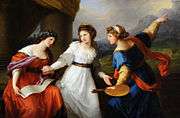
In 1781, after her first husband's death (she had been long separated from him), she married Antonio Zucchi (1728–1795), a Venetian artist then resident in England.[18] Shortly afterwards she retired to Rome, where she befriended, among others, Johann Wolfgang von Goethe; yet, always restive, she wanted to do more and lived for 25 years with much of her old prestige.[18]
In 1782, Kauffman's father died, as did her husband in 1795. In 1794, she painted, Self-Portrait Hesitating Between Painting and Music, in which she emphasizes the difficult choice in choosing painting as her sole career, in dedication to her mother's death.[7] She continued at intervals to contribute to the Royal Academy in London, her last exhibit being in 1797. After this she produced little, and in 1807 she died in Rome, being honored by a splendid funeral under the direction of Canova. The entire Academy of St Luke, with numerous ecclesiastics and virtuosi, followed her to her tomb in Sant'Andrea delle Fratte, and, as at the burial of Raphael, two of her best pictures were carried in procession.[18]
Legacy

By 1911, rooms decorated with her work were still to be seen in various quarters. At Hampton Court was a portrait of the duchess of Brunswick; in the National Portrait Gallery, a self-portrait (NPG 430).[18][22]
There were other pictures by her in Paris, at Dresden, in the Hermitage at St Petersburg, in the Alte Pinakothek at Munich, in Kadriorg Palace, Tallinn (Estonia)[18][23] and in the Joanneum Alte Galerie at Graz. The Munich example was another portrait of herself, and there was a third in the Uffizi at Florence. A few of her works in private collections were exhibited among the Old Masters at Burlington House.[18]
Kauffman is also well known by the numerous engravings from her designs by Schiavonetti, Francesco Bartolozzi and others. Those by Bartolozzi especially found considerable favour with collectors. Charles Willson Peale (1741–1827), artist, patriot, and founder of a major American art dynasty, named several of his children after notable European artists, including a daughter, Angelica Kauffman Peale.[18]
A biography of Kauffman was published in 1810 by Giovanni Gherardo De Rossi.[18][10] The book was also the basis of a romance by Léon de Wailly (1838) and it prompted the novel contributed by Anne Isabella Thackeray to the Cornhill Magazine in 1875 entitled "Miss Angel".[18]
The Angelika Kauffmann Museum
The Angelika Kauffmann Museum in Schwarzenberg, Vorarlberg (Austria) was established in 2007. The annually changing exhibitions focus on different aspects and themes of her artistic work.[24] In the 2019 exhibition "Angelika Kauffmann – Unknown Treasures from Vorarlberg Private Collections", many of her paintings were shown to the public for the first time, as a large parts of her oeuvre are owned by private collectors.[25] The museum is housed in the so-called "Kleberhaus", an old farmhouse in the typical architectural style of the region.[26]
Gallery
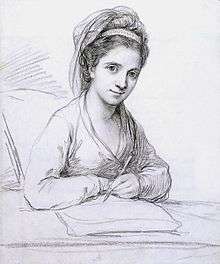 Self-Portrait as Imitatio. Pencil, 1771.
Self-Portrait as Imitatio. Pencil, 1771.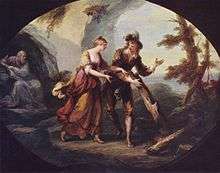 Miranda and Ferdinand in The Tempest, 1782.
Miranda and Ferdinand in The Tempest, 1782. The Paintress of Macaroni's, believed to be a satire of Kauffmann. London: Printed for Carington Bowles, 13 April 1772.
The Paintress of Macaroni's, believed to be a satire of Kauffmann. London: Printed for Carington Bowles, 13 April 1772. A Sleeping Nymph Watched by a Shepherd, about 1780, Angelica Kauffman V&A Museum no. 23-1886
A Sleeping Nymph Watched by a Shepherd, about 1780, Angelica Kauffman V&A Museum no. 23-1886- Kauffman's 1787 painting of Goethe, then 38 years old
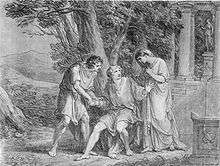 Scene from the 1802 première in Weimar of Goethe's Iphigenia in Tauris, with Goethe himself as Orestes in the centre.
Scene from the 1802 première in Weimar of Goethe's Iphigenia in Tauris, with Goethe himself as Orestes in the centre. From The European Magazine and London Review
From The European Magazine and London Review Troilus and Cressida, Act V, Scene II (1789), one of her many Shakespeare tableaux. Engraved in 1795 for an edition of Shakespeare by the Boydell Shakespeare Gallery.
Troilus and Cressida, Act V, Scene II (1789), one of her many Shakespeare tableaux. Engraved in 1795 for an edition of Shakespeare by the Boydell Shakespeare Gallery. Kauffman's El juicio de Paris at Museo de Arte de Ponce, Ponce, Puerto Rico
Kauffman's El juicio de Paris at Museo de Arte de Ponce, Ponce, Puerto Rico Fr. Bartolozzi after A. Kauffmann. The beautiful Rhodope in love with Aesop. 1780
Fr. Bartolozzi after A. Kauffmann. The beautiful Rhodope in love with Aesop. 1780 Kauffman (seated), in the company of other "Bluestockings". Richard Samuel, 1778.
Kauffman (seated), in the company of other "Bluestockings". Richard Samuel, 1778. Portrait of a Woman as a Vestal Virgin (1780s)
Portrait of a Woman as a Vestal Virgin (1780s)
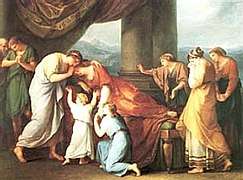 Death of Alcestis, 1790
Death of Alcestis, 1790
Notes and references
Notes
- Kauffman is the preferred spelling of her name in English; it is the form she herself used most in signing her correspondence, documents and paintings.[1]
- Conner attributes the allegation to Jacques Pierre Brissot, who reported it as hearsay in his Mèmoirs, 1754–1793 (1912), but does not find the evidence for it compelling.[14]
- The original sketch was discovered in Brazil in September 1966 and bought by Tate Britain the following year.[15] The finished painting's whereabouts were unknown until it appeared at auction in 1944. It was acquired in 1967 and is now in the National Gallery of Ireland in Dublin.[16][15]
- King Francis I had become a close friend of Leonardo da Vinci during the artist's last years, and Vasari records that the King held Leonardo's head in his arms as he died. Aside from Kauffman, this story was portrayed in romantic paintings by Ingres, Ménageot and other French artists, though some historians consider it legend rather than fact.[19]
References
- Roworth 1992, p. 193.
- The Royal Academy n.d.
- NMWA n.d.
- Townsend 2008, p. 105.
- Johns 2011.
- AKRP: Chronology.
- AKRP: Biography.
- Ratiner 2005.
- Dobson 1911, p. 697.
- Roworth 2004.
- Roworth 2013.
- Dobson 1911, pp. 697–698.
- Loftus 2014.
- Conner 2012, pp. 3, 13.
- Postle 2001.
- National Gallery of Ireland n.d.
- Rosenthal 2006, pp. 226–227.
- Dobson 1911, p. 698.
- White 2000, pp. 261–262.
- Roworth 1997, pp. 766–770.
- Roworth 1997, p. 766.
- NPG 430.
- Art Museum of Estonia 2013.
- "Angelika Kauffmann Museum - Tourismus Schwarzenberg". www.schwarzenberg.at. 28 August 2019. Retrieved 10 September 2019.
- "The Angelika Kauffmann Museum in Schwarzenberg". Bregenzerwald in Vorarlberg. Retrieved 10 September 2019.
- "Angelika Kauffmann Museum - Tourismus Schwarzenberg". www.schwarzenberg.at. 28 August 2019. Retrieved 10 September 2019.
Bibliography
![]()
- Baumgärtel, Bettina, ed. (n.d.). "Biography". Angelika Kauffmann Research Project. Retrieved 2 December 2018.
- Baumgärtel, Bettina, ed. (n.d.). "Chronology". Angelika Kauffmann Research Project. Retrieved 2 December 2018.
- Conner, Clifford D. (2012). Jean-Paul Marat: Tribune of the French Revolution. Revolutionary Lives. Pluto Press. ISBN 9780745331935.CS1 maint: ref=harv (link)
- "Art Museum of Estonia". EKM Digitaalkogu. 2013. Retrieved 15 February 2013.
- Johns, Elizabeth (4 February 2011). "Keepsakes of the Beloved: Portrait Miniatures and Profiles 1790 to 1840". Traditional Fine Arts Organization. Retrieved 2 December 2018.CS1 maint: ref=harv (link)
- Loftus, Simon (Winter 2014). "From chaplains to lords". Irish Arts Review.CS1 maint: ref=harv (link)
- "The Conjuror". National Gallery of Ireland. n.d. Retrieved 3 December 2018.
- "Angelica Kauffman: 1741–1807". The National Museum of Women in the Arts. n.d. Retrieved 2 December 2018.
- "NPG 430; Angelica Kauffman". National Portrait Gallery. Retrieved 2 December 2018.
- Postle, Martin (2001). "Sketch for The Conjuror, Nathaniel Hone, 1775". Tate Britain. Retrieved 3 December 2018.CS1 maint: ref=harv (link)
- Ratiner, Tracie, ed. (2005). "Kauffman, Angelica". Encyclopedia of World Biography. 25 (2nd ed.). Detroit, MI: Gale. pp. 229–231 – via Gale Virtual Reference Library.CS1 maint: ref=harv (link)
- Rosenthal, Angela (2006). Angelica Kauffman: Art and sensibility. New Haven: Yale University Press. ISBN 9780300103335.CS1 maint: ref=harv (link)
- Roworth, Wendy Wassyng, ed. (1992). Angelica Kauffman: A Continental Artist in Georgian England. London: Reaktion Books. ISBN 9780948462412.CS1 maint: ref=harv (link)
- Roworth, Wendy Wassyng (1997). "Kauffman [Kauffmann], Angelica". In Gaze, Delia (ed.). Dictionary of Women Artists. 2. London and Chicago: Fitzroy Dearborn. pp. 764–770. ISBN 1-884964-21-4.CS1 maint: ref=harv (link)
- Roworth, Wendy Wassyng (2004). "Documenting Angelica Kauffman's Life and Art". Eighteenth-Century Studies. American Society for Eighteenth-Century Studies. 37 (3): 478–482. doi:10.1353/ecs.2004.0031. eISSN 1086-315X. ISSN 0013-2586 – via Project MUSE.CS1 maint: ref=harv (link)
- Roworth, Wendy Wassyng (2013). "Kauffman [Kauffmann], Angelica". In Gaze, Delia (ed.). Concise Dictionary of Women Artists. Routledge. pp. 401–406. ISBN 9781136599019.CS1 maint: ref=harv (link)
- "Angelica Kauffman RA (1741–1807)". The Royal Academy. n.d. Retrieved 2 December 2018.
- Townsend, Joyce, ed. (2008). Preparation for Painting: The Artist's Choice and its Consequences. Archetype Publications. ISBN 9781904982326.CS1 maint: ref=harv (link)
- White, Michael (2000). Leonardo: The First Scientist. New York: St. Martin's Press. ISBN 9780312203337.CS1 maint: ref=harv (link)
Exhibitions
- Retrospektive Angelika Kauffmann (270 works, c. 450 ill. ), Düsseldorf, Kunstmuseum (15 November 1998 – 24 January 1999); München, Haus der Kunst (5 February - 18 April 1999); Chur, Bündner Kunstmuseum (8 May – 11 July 1999).
Further reading
| Wikisource has original works written by or about: Angelica Kauffman |

- Bettina Baumgärtel (ed.): Retrospective Angelika Kauffmann, Exh. Cat. Dusseldorf, Kunstmuseum; Munich, Haus der Kunst, Chur, Bündner Kunstmuseum, Ostfildern, Hatje 1998, ISBN 3-7757-0756-5.
- Kauffmann, Angelica. (2001). "»Mir träumte vor ein paar Nächten, ich hätte Briefe von Ihnen empfangen«. Gesammelte Briefe in den Originalsprachen. Ed. Waltraud Maierhofer. Lengwil: Libelle, 2001. ISBN 978-3-909081-88-2 (Letters in German, English, Italian, French; introduction and commentary in German.)
- Kauffmann, Angelika. (1999) "Briefe einer Malerin." Ed. Waltraud Maierhofer. Mainz: Dieterich'sche Verlagsbuchhandlung.
- Manners, Lady Victoria and Williamson, Dr. G.C. Angelica Kauffmann, R.A.: Her Life and Works. London: John Lane the Bodley Head, 1924.
- Natter, Tobias (ed.). Angelica Kauffmann: A Woman of Immense Talent. Ostfildern: Hatje-Cantz, 2007. ISBN 978-3-7757-1984-1.
- The European Magazine and London Review, April 1809 "Memoir of the Lady Angelica Kauffman, R. A." by Joseph Moser, Esq.
External links
| Wikimedia Commons has media related to Angelica Kauffmann. |
- Information Angelika Kauffmann in Schwarzenberg ((in German), also contains information and articles both in English and Italian)
- Vorarlberg Landesmuseum in Bregenz
- Index to the edition of her correspondence on the publisher's site
- Angelica Kauffman Research Project
- 80 paintings by or after Angelica Kauffman at the Art UK site
